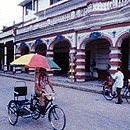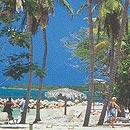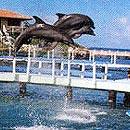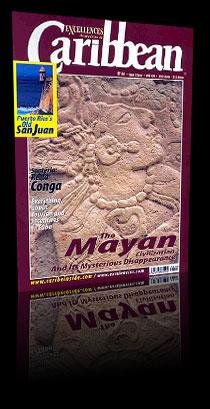The most beautiful, hospitable and friendly land
In the past 15 years, Holguin –in the north side of eastern Cuba- has become a diversified tourist destination teeming with an array of hotel and extra-hotel offers, let alone multiple nautical and sport choices, cultural recreation and nature adventure for roughly 10,000 visitors at a time.
This gorgeous Cuban region and its mystical attributes have left footprints in the memory of thousands of travelers around the world. This is the most beautiful land –as Admiral Christopher Columbus put it when he beheld this unexplored territory during his discovery journey- and also the most hospitable and friendly place there is with a population edging one million inhabitants.
Top-of-the-line health care and security to wander everywhere are two additional virtues of Holguin, a province whose major tourist circuits –Guardalavaca, Esmeralda and Pesquero- are perched along the shoreline and sheltered by coastal ecosystems and a peculiarly charming Caribbean-type coral reef .
In the winter of 2003-2004, Yuraguanal will get its big break as the fourth beach for international tourists in the province of Holguin following the grand opening of its first hotel, a 540-room resort. The new location now provides travelers with further lodging chances in a shifting and intimate destination.
HOTEL NETWORK FOR ALL TASTES AND BUDGETS With the opening of this new resort, Holguin has now ratcheted up its room stock to 5,000 accommodations in 18 hotels –over a third of them labeled as five-star and four-star establishments, and most of them built in one-to-two-story villas or bungalows run by Cuban hotel groups Cubanacan, Islazul and Gaviota.
Gaviota S.A. runs a considerable chunk of these facilities, including three of them in a joint effort with Spanish chain Sol Meliá (the five-star Paradisus Rio de Oro and two four-star resorts: the SolClub Rio de Luna and Rio de Mares, all of them in Playa Esmeralda). Other facilities here are the LTI Costa Verde Beach, the five-star SuperClubs Breezes Costa Verde, and the five-star Playa Pesquero Hotel, all in the same location the latter is named after. The Yuraguanal is also run by Gaviota.
Cubanacan S.A. reigns in Guardalavaca, a place no wonder tagged as a paradise inside another paradise: Cuba and the Caribbean. Two of Cubanacan's trademarks operate here: the Brisas Guardalavaca (hotel and villa) and the Club Amigo Atlantico Bungalows, all featuring beachfront rooms and facilities.
Islazul owns a number of resorts in different cities, mainly in Holguin and Moa, and the company runs establishments in such exclusive spots as the Mayabe and Loma de la Cruz watchtowers. From the Loma de la Cruz watchtower, travelers can make out Holguin, the city of parks, resembling a giant chessboard of straight and wide streets. The city rests atop a valley where an Iberian-American culture marked by dancing, guitar strumming, lyrical singing, zarzuelas, opera, museums, art workshops and galleries, and the performing arts bloom every step of the way.
WALK OUT OF THE HOTEL AND LIVE TO TELL Indeed, it's possible to revel to the utmost in the surrounding natural virtues. All beaches are equipped with scuba diving training centers and nautical facilities for tourists to ride aboard catamarans and boats that take them along the coastline and into history. A case in point is the tour to Bariay Key, the exact spot where Christopher Columbus landed in 1492.
Near the beaches, trippers may access to the Puerto de Vita International Marina with 38 docking piers and a variety of top-rated services as technical maintenance and repair. A seaquarium brimming with tropical marine life, a dolphin show and the chance to take a swim with those long-snout fish make Naranjo Key one of the most awe-inspiring places around. Las Guanas Ecological Trail, featuring a visual information system that stretches across 16 acres, plus a maritime watchtower standing tall on the highest point, are two other must-sees.
Nightlife satisfaction is in the bag with La Roca Disco Club, the Café Cantante at the Club Amigo Atlantico Guardalavaca Hotel and the disco club at the Brisas Guardalavaca Hotel.
As far as culture, history and landscapes are concerned, there are some sightseeing places of general interest as the Taino Village at the Chorro de Maita Archeological Site and its aboriginal cemetery. Don't miss out on the chance to drop by the Christopher Columbus and Naranjo Bay nature parks, featuring a pet zoo and the Conuco de Mongo Viña, a countryside-style restaurant.
Cayo Saetia –a key off the Nipe Bay waters where travelers can get to by car or by chopper- has become Cuba's flora and wildlife Eden. The key also harbors 19 species of exotic animals, including antelopes, white-tail deer, zebras, water buffaloes, parrots and ostriches that run in packs, flocks and herds from dusk to dawn. There are several unexplored beaches on the premises: Punta El Ramon and Corintia are two cases in point. This whole area is called Antilla, Holguin's next tourist circuit.
Canada with 36 percent of vacationers, followed by Germany (24 percent), England (11 percent), Italy and France (7 percent each) and Switzerland with 5 percent of the total amount of travelers, have been the top tourist-sending markets for Holguin for the past 15 years. Holguin is one of Cuba's eight premiere tourist destinations, rubbing elbows with the likes of Havana, Varadero, Jardines del Rey, Santa Lucia, Santiago de Cuba, the Southern Central Coast (Trinidad-Cienfuegos, and the Canarreos Archipelago.
Holguin is once again a benchmark for Spaniards. They brought along the very first tourist to ever land on these beaches, and centuries of silence passed by since the Great Admiral set foot on these sands. Not anymore. Castanets are crackling again and new eyes are setting sight on the horizon. This is a second face-to-face encounter with new realities and hopes this time around.
The Taino Village
If you're interested in delving into the historic and cultural background of this noticeable location, you must drop in on the Taino Village at the Chorro de Maita Archeological Site and its aboriginal cemetery where time seems to be standing still.






































































